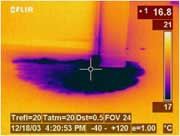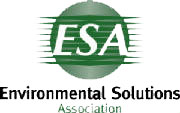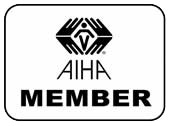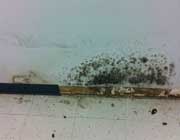Why Mold Test?
There are many valid and valuable reasons to perform mold testing. Here are 10 reasons.
Frequent Questions
Get answers to frequently asked questions about mold with our expertise.
Tool Spotlight: BCAM® Infrared Camera

One of the latest tools Mold Inspectors can use to detect mold "hot spots" in places that cannot be seen easily is the BCAM® infrared camera. This kind of equipment and technology offers the mold inspector a non-invasive means of monitoring and diagnosing the conditions of buildings - providing immediate high-resolution thermal imagery, revealing potential structural and moisture issues, energy efficiency and even rodent or pest discovery. The BCAM® infrared camera features an automatic color alarm alerts yout to moisture-laden areas during building scans which can detect potential areas of mold growth, as well as verify when structures are moisture-free during the drying out process. With the BCAM the Mold Inspector can inspect places that can't be physically reached with moisture meters. The BCAM reveals wet conditions behind surfaces such as: enameled walls and wallpaper that don't readily water stain, track leaks to their source, monitor the drying process, and confirm when a structure is dry. Indoor Air Quality (IAQ) deals with the content of interior air that could affect health and comfort of building occupants. The IAQ may be compromised by microbial contaminants (mold, bacteria), chemicals(such as carbon monoxide,radon}, allergens, or any mass or energy stressor that can induce health effects. Often it is perceived that outdoor air is polluted, but indoor air is acceptable. Scientific studies illustrate the falsity of this perception, and, in fact, indoor air is often a greater health hazard than the corresponding outdoor setting.
When should you have a mold inspector test for mold in your home?
- When purchasing a new home. This is especially important if the home you are purchasing is listed "as-is" or has been vacant for an extended period of time.
- After any type of flooding or water event has occured in the home.
- When a pipe leak or roof leak has brought water into the walls of the home.
- When you smell mold or mildew, even if it is not visually noticable.
- If dark stains appear on fabrics, furniture, walls or carpeting that has no other cause.
- If anyone in your home is suffering respiratory problems, frequent asthma attacks or other illnesses that cannot be connected to any other cause.
- You should also consider a periodic mold inspection if your home is located within a wooded area or very close to a body of water. Both of these living are perfect for mold growth.
Diseases that are associated with mold contamination include:
- Enhanced asthmatic symptoms.
- Sinus infections.
- Respiratory conditions causing wheezing and fatigue.
- Bloody nose
- Recurrent ear and throat infections
- Patches of discoloration on the skin that can lead to abscesses.
- Black mold has also been associated with Sick Building Syndrome.
What are the structual effects of mold?
Mold can be a corrosive and it can cause damage to any "food source" to which it attaches itself. Mold will destroy drywall, causing it to crumble, if left untreated. Wood can also become brittle and crumble when mold has remained on the surface for an extended period of time.
Chicago Mold Inspection - What takes Place
When we conduct a mold inspection on your home, you can expect the following:
- Visual mold inspection. Our extensively trained inspectors will visually inspect your proprerty for any noticeable signs of mold. Great care will be taken in areas where mold tends to accumulate, such as bathroom and kitchen areas, closets, and areas located near pipes. If we suspect that the walls are damp, the inspector will use the thermal imaging camera and moisture meter to better find the locate the leak or source of moisture. He may also choose to use tools like a c02 meter, humidity meter, boroscope, and items like that.
- Mold samples. If mold is found on any surface area, swabs will be taken and sent for analysis. Determining the type of mold strain infecting your home will allow the mold remediation team to treat the area correctly. Air samples in and around the outside of the home will be taken to check the amount of spores in the air. Concentrated amounts of spores will signal growth areas. Air samples will be evaluated at a laboratory for concentration levels and mold type.
- Laboratory Reports. Once the AIHA accredited laboratory has analyzed the samples and given its report, you will be given a chance to go over the laboratory results with a trained hygienist and if neccesary the mold inspector will provide you with a copy of the report and any recommendations for mold removal. The lab report is a certified document and can be used as a legal document.
- Recommendations. If your laboratory results from mold testing Chicago reports the samples taken and visual inspections show signs of excessive mold growth, the inspector will provide you with recommendations on mold remediation. Mold remediation or removal should be carried out by a professional. Mold removal requires special chemicals, HEPA air filtration, moisture removal, and special cleaning. Depending on the extent of the mold infiltration, replacement of drywall may be necessary. Due to the effects mold can have on the lungs, these professional companies use special masks for breathing, as well as treated clothing, to prevent any additional mold contamination or sickness.
- Final Air Sampling. Once the mold has been cleaned and removed, mold testing Chicago will return to take air samples of the affected areas. The air samples will be submitted to the lab, and the final results will be provided to the home owner. These results should show a decreased and acceptable amount of spore activity in their property
A few facts about mold
Mold can be found everywhere. It is a crucial part of the environment, and not all of the mold that exists is bad or destructive. There are many good strains of mold, including the one used to create Penicillin and the ones used to make yeast for bread. It is the bad strains of mold that you must watch for and remove if they enter into your home.
Mold spores can enter your home through your clothing, an open window, and on the fur of your pet. Most spores die once they enter the home. However, there are cases, especially after a flood, when the conditions are right in the home to create a mold breeding area. This is why it is so important to have an inspection after a flood occurs.
We only offer mold inspection services
Our company believes that it would be a conflict of interests if we offered mold inspection and mold removal services. It is in the best interest of the consumer for us to only offer the inspection services, so that home owners can feel positive that we will not "Discover mold" simply to sell them remediation services. All of our tests are conducted in a non-biased and professional manner.
Our company currently has the largest network of professional mold inspectors in the country. Our inspectors have all been professionally educated and trained in this field and have the resources and equipment necessary to conduct professional inspections. Inspectors are available seven days a week, allowing home owners to schedule inspections at their own leisure. Since 1997, we have been providing excellent customer service to all of our clients, and offer each a 100 percent guarantee that they will be happy with our inspection.Mold Certifications




Mold Pictures On Our Pinterest! Check Out The ISCT Mold Glossery While You View Our Pinterest!
Don't Let this Happen to You
